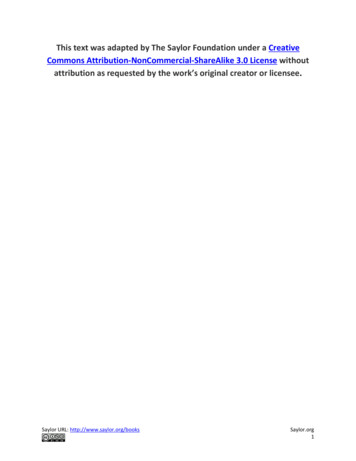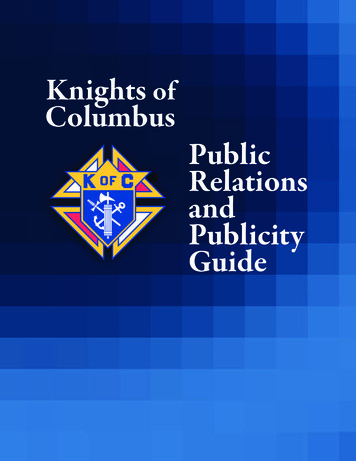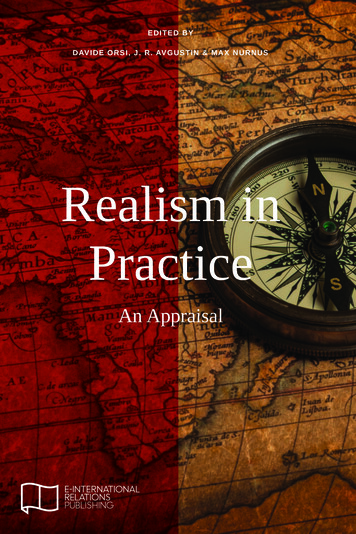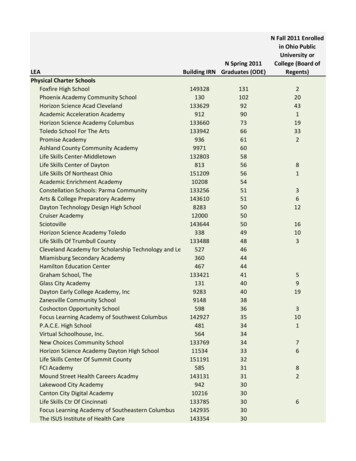
Transcription
This text was adapted by The Saylor Foundation under a CreativeCommons Attribution-NonCommercial-ShareAlike 3.0 License withoutattribution as requested by the work’s original creator or licensee.Saylor URL: http://www.saylor.org/booksSaylor.org1
PrefaceKnowing how to get along with others, resolve workplace conflict, manage relationships,communicate well, and make good decisions are all critical emotional intelligence skills studentsneed to succeed in career and in life. Our Human Relations book will address all of the critical topicsto obtain career success. This book isn’t an organizational behavior (OB) text, which is too theoreticalfor many of our students’ needs. While this book will focus on some of the theories you might find inan OB book, the focus is a direct benefit to students in their current and future jobs.This book also isn’t a professional communications, business English, or professionalism book, asthe focus is much broader: it focuses on general career success and how to effectively maneuver inthe workplace.The core concept in the book is emotional intelligence and how these skills carry over into careersuccess, such as through ethics, communication, diversity, teamwork, conflict, good decision making,stress management, motivation, and leadership.This book’s easy-to-understand language and tone is written to convey practical information in anengaging way. Plenty of examples are included in each chapter so students understand the conceptsand how the concepts can benefit their career. This book will meet the needs of a course in thebusiness department or will be offered to professional technical students in any number of careerfields, such as automotive, dental hygiene, culinary, or technology. In addition, this book would be agreat addition to any school offering human relations course for teacher certification.This book could be used in the following courses: Human relations Psychology Career-focused courses Professionalism Business communications Teacher/education certificationFeaturesEach chapter opens with a realistic example that introduces a concept to be explained in detail later. Eachchapter contains relevant examples, YouTube videos, figures, learning objectives, key takeaways, WhySaylor URL: http://www.saylor.org/booksSaylor.org2
Human Relations? boxes, exercises, and a chapter-ending case that offer different ways to promotelearning.Saylor URL: http://www.saylor.org/booksSaylor.org3
Chapter 1What Is Human Relations?I present myself to you in a form suitable to the relationship I wish to achieve with you.- Luigi PirandelloIf you don’t like something, change it. If you can’t change it, change your attitude.- Maya AngelouNo One Wants to Work with HerJenny is going to a BBQ at Monica and Harvey’s house this afternoon. Because it is a big annualevent, it is usually a large party. She will likely know about half the people, as Monica and Harveyinvite people from all aspects of their lives. As Jenny enters the backyard, she sees familiar faces, asexpected, but also sees a lot of people she doesn’t recognize. Immediately she starts fidgeting, asJenny isn’t good at making small talk. Instead of making eye contact and going over to people whoare acquaintances, she drops her potluck dish down, grabs a drink from the cooler, and tries to findMonica so she will have someone to talk with.At work, Jenny avoids interpersonal relationships and small talk because she is uncomfortablerevealing too much of herself. When Jenny attends meetings at work, she sighs impatiently whensomeone is late and when people veer too far from the topic, and she makes sure to bring peopleback to reality. When choosing project teams, people rarely want to work with Jenny, even thoughshe is very capable in her job. Some of the women from the office get together for lunch on Tuesdays,but Jenny is never invited. Needless to say, Jenny isn’t well liked at work.We have all met someone like Jenny, who is seemingly uncomfortable with herself and unpleasant.We may even try to avoid the Jennys we know. Despite Jenny being good at her job, no one wants towork with her. You would think that success at work only takes talent at job-specific tasks. However,this isn’t the case. As we will discuss throughout this chapter and the book, successful people havethe skills to do the job, but they also have the human relations skills to get along with others. TheSaylor URL: http://www.saylor.org/booksSaylor.org4
focus of this chapter will be personality, attitudes, self-esteem, and perceptions—all of these topicsand more impact our ability to get along with others.1.1 Why Study Human Relations?LEARNING OBJECTIVES1. Be able to define human relations.2. Discuss why human relations skills are necessary in your future workplace.3. Explain how the progression of human relations studies relates to today’s human relations in your life.The study and understanding of human relations can help us in our workplace, and as a result, assist us inachieving career success. The better our human relations, the more likely we are to grow bothprofessionally and personally. Knowing how to get along with others, resolve workplace conflict, managerelationships, communicate well, and make good decisions are all skills we will discuss throughout thebook.Why Human Relations?So, what is human relations? We can define human relations as relations with or between people,particularly in a workplace or professional setting.[1]From a personal perspective, there are manyadvantages to having good human relations skills. First, of the top ten reasons people are fired, severalreasons relate back to lack of human relations skills—for example, the inability to work within a team,personality issues, sexual harassment, and dishonesty.[2]Other reasons, perhaps not directly related tohuman relations, include absenteeism, poor performance, stealing, political reasons, downsizing, andsabotage. Second, people who are competent team players and have a good work ethic tend to getpromoted faster.[3]In fact, according to guru on personal development Brian Tracy, 85 percent of yoursuccess in life is determined by social skills and the ability to interact positively and effectively withothers.[4]Another reason to develop good relationships with others relates to your own personalSaylor URL: http://www.saylor.org/booksSaylor.org5
happiness. According to psychologist Sydney Jourard, most joy in life comes from happy relationshipswith other people.[5]Consider John, a very talented project manager but lacking in human relations skills. While he is easilyable to plan and execute the finest details for a project, no one likes to work with him. He doesn’t makeefforts to get to know his team members and he comes across as unfriendly and unapproachable. Howsuccessful do you think John will be in his workplace? While he has the skills necessary to do the job, hedoesn’t have the people skills that can help him excel at it. One could say he does not have emotionalintelligence skills—that is, the ability to understand others—therefore, he may always find himselfwondering why he isn’t more successful at work (we will discuss emotional intelligence in Chapter 2"Achieve Personal Success"). While project management skills are something we can learn, managers findit difficult to hire people without the soft skills, or human relations skills. We aren’t saying that skills arenot important, but human relations skills are equally as important as technical skills to determine careerand personal success. Consider human relations skills in your personal life, as this is equally important.Human relations skills such as communication and handling conflict can help us create betterrelationships. For example, assume Julie talks behind people’s backs and doesn’t follow through on herpromises. She exhibits body language that says “get away from me” and rarely smiles or asks people aboutthemselves. It is likely that Julie will have very few, if any, friends. If Julie had positive human relationsskills, there is a much better chance she could improve her personal relationships.We can benefit personally and professionally from good human relations skills, but how do organizationsbenefit? Since many companies’ organizational structures depend upon people working together, positivehuman relations skills reduce conflict in the workplace, thereby making the workplace moreproductive. Organizational structures refer to the way a company arranges people, jobs, andcommunications so that work can be performed. In today’s business world, teams are used to accomplishcompany goals because teamwork includes people with a variety of skills. When using those skills in ateam, a better product and better ideas are usually produced. In most businesses, to be successful at ourjob, we need to depend on others. The importance of human relations is apparent in this setting. If peopleare not able to get along and resolve conflicts, the organization as a whole will be less productive, whichcould affect profitability. Many organizations empower their employees; that is, they give employeesfreedom in making decisions about how their work gets done. This can create a more motivatedSaylor URL: http://www.saylor.org/booksSaylor.org6
workforce, which results in more positive human relations. We will explore this topic further in Chapter 6"Understand Your Motivations".Most organizations employ a total person approach. This approach recognizes that an organization doesnot just employ someone with skills, but rather, the whole person. This person comes with biases,personal challenges, human relations skills, and technical skills but also comes with experiences. Bylooking at a person from this perspective, an organization can begin to understand that what happens toan employee outside of work can affect his or her job performance. For example, assume Kathy is doing agreat job at work but suddenly starts to arrive late, leave early, and take longer lunches. Upon furtherexamination, we might find that Kathy is having childcare issues because of her divorce. Because of a totalperson approach perspective, her organization might be able to rearrange her schedule or work with herto find a reasonable solution. This relates to human relations because we are not just people going to workevery day; we are people who live our personal lives, and one affects the other. Because of this, our humanrelations abilities will most certainly be affected if we are experiencing challenges at home or at work.The linked image cannot be displayed. The file may have been moved, renamed, or deleted. Verify that the link points to the correct file and location.[6]Evolution of Human Relations StudyHuman relations, however, was not always central to the conversation on organizational success. In fact,until the 1940s, little thought was given to the human aspect of jobs. Many of the jobs in the early 1900swere focused on production and located in factory-like settings where the jobs themselves were repetitive.The focus in these types of work environments was on efficiency. We can call this time period of humanrelations studies the classical school of management. This school of thought took place from 1900 to theearly 1920s. Several theories were developed, which revolved around the idea of efficiency, or getting a jobdone with the least amount of steps.Saylor URL: http://www.saylor.org/booksSaylor.org7
Frederick W. Taylor was an engineer who today is known as the father of scientific management. Hebegan his career in a steel company and, because of his intimate knowledge of the industry, believed thatorganizations could analyze tasks to make them performed with more efficiency.Following his work, Frank and Lillian Gilbreth performed numerous studies on physical motions workerstook to perform specific tasks and tried to maximize efficiency by suggesting new ways to perform thetasks, using less energy and thereby being more efficient.While Taylor and Gilbreth’s research was more focused on physical motions and tasks, Henri Fayol beganlooking at how management could improve productivity instead of focusing on specific tasks and motions.Fayol created the Fourteen Principles of Management, which focused on management but also hinted tothe importance of human relations:1.[7]Division of work. Work should be divided in the most efficient way. Fayol believed workspecialization, or the focus on specific tasks for teams or individuals, to be crucial to success.2. Authority. Authority is the right to give orders and accountability within those orders. Fayolbelieved that along with giving orders and expecting them to be met, that person in authority alsoassumes responsibility to make sure tasks are met.3. Discipline. Discipline is penalties applied to encourage common effort, as a successful organizationrequires the common effort of all workers.4. Unity of command. Workers should receive orders from only one manager. In other words,reporting to two or more managers would violate Fayol’s Fourteen Principles of Management.5.Unity of direction. Everyone in the organization should move toward a common goal andunderstand how the team will achieve that goal.6. Subordination of individual interests to general interests. The interests of one personshouldn’t have priority over the interests of the organization as a whole. This focuses on teamworkand the importance of everyone acting toward the same goal.7.Remuneration. Many things should be considered when paying employees, including cost of living,supply of qualified people, and business success.8. Centralization. The degree of importance in the subordinates’ (employees’) role in theirorganization and the amount of decision making that occurs at a central level versus a decentralizedlevel. For example, in many organizations decisions are made centrally (i.e., in the “corporate office”),Saylor URL: http://www.saylor.org/booksSaylor.org8
which does not allow as much flexibility as decentralized decision making; this would mean eachindividual area can make its own decisions.9. Scalar chain. This refers to how authority is divided among managers. Specifically, Fayol saidlower-level managers should always keep upper-level managers informed.10. Order. All materials and people related to one kind of work should be organized and neat. Thingsshould be easy to find.11. Equity. All employees should be treated equally.12. Stability of tenure of personnel. Retention of employees should be a high management priority.The cost of hiring a new worker is expensive, so efforts should be maintained to keep currentemployees.13. Initiative. Management should take steps to encourage workers to take initiative. In addition,workers should be self-directed and not need a lot of management control to accomplish tasks.14. Esprit de corps. Managers should encourage harmony among employees. This harmony createsgood feelings among employees.Fayol’s research was some of the first that addressed the need for positive human relations in a workenvironment. As further research was performed into the 1920s, we moved into a new period of humanrelations studies called the behavioral school of management. During this time period, employeeshad begun to unionize, bringing human relations issues to the forefront. Because workers demanded amore humane environment, researchers began to look at how organizations could make this happen.One of the more notable researchers was Elton Mayo, from Harvard Business School, and his colleagues.They conducted a series of experiments from the mid-1920s to early 1930s to investigate how physicalworking conditions affected worker productivity. They found that regardless of changes such as heat,lighting, hours, and breaks, productivity levels increased during the study. The researchers realized theincreased productivity resulted because the workers knew they were being observed. In other words, theworkers worked harder because they were receiving attention and felt cared about. This phenomenon iscalled the Hawthorne effect (named for the electrical plant for which the experiments were conducted).In the 1950s, researchers began to explore management techniques and the effect on worker satisfaction.Saylor URL: http://www.saylor.org/booksSaylor.org9
This was called the behavioral science approach. These techniques used psychology, sociology, andother human relations aspects to help researchers understand the organizational environment.Since the 1960s, research on human relations has been much easier to assimilate because of technologyand a focus on statistical analysis. Hence, this is called the management science school. So whileresearch today focuses on the human relations aspect, we are now able to use complex statistical modelsto improve efficiency and productivity while still focusing on the human relations component.Human Relations, Technology, and GlobalizationWhile we discuss the impact of technology on human relations throughout the book, it is important tomention here the immense impact technology has had on this field of study. Inability to see body languageindicators make it more difficult to communicate using technology, creating conflict andmisunderstandings. These misunderstandings can obviously affect human relations. Also consider thatthrough globalization, we are working with people from all over the world in many time zones who havedifferent perspectives. Between technology and globalization, humans have never had to work with such adiverse group of people—using diverse methods of communication—at any time in history.Technology has allowed us to do this: e-mail, Skype, and instant message, to name a few. The impact onhuman relations is obvious—there is less face-to-face interactions and more interactions using technology.Add in the challenge of a global environment and this creates a whole new set of challenges.Many organizations today are focusing on how to use technology to save workers time commuting towork. In fact, an estimated 26.2 million workers telecommute, or work from a remote location at least[8]once per month. Global Workplace Analytics cites the following benefits to telecommuting:1.Improved employee satisfaction2. Reduced unscheduled absences3. Increased productivityHowever, Global Workplace Analytics also says there are some key drawbacks:1.[9]Social needs may not be met2. People must be self-directed3. Employees must be comfortable with technology or it won’t workSaylor URL: http://www.saylor.org/booksSaylor.org10
While technology has greatly impacted human relations at work, there are some common denominatorsfor human relations success in today’s workplace—whether or not technology is used. These factors will bediscussed throughout this book: Chapter 1 "What Is Human Relations?". Understanding how personality, attitudes, self-esteem, andperception impact human relations. How we are, how we behave, and our belief systems all impacthow we view ourselves and others. Chapter 2 "Achieve Personal Success". Understanding the components to personal success, such asgoal setting and emotional intelligence skills. Being able to achieve personal success is the first step inattaining career success. Chapter 3 "Manage Your Stress". Managing stress and understanding how too much stress cannegatively impact our human relations. Chapter 4 "Communicate Effectively". Communication abilities. Everything we do at work and in ourpersonal lives involves communication. Understanding how to communicate effectively is thecornerstone of positive human relations. Chapter 5 "Be Ethical at Work". Ethical decision making is necessary because ethical decisions mustbe made all the time in our personal and work lives. Understanding how to make an ethical decisioncan help us become better employees and human beings. Chapter 6 "Understand Your Motivations". Understanding what motivates you can help you know theright career path and can assist you in guiding your supervisor. Without an understanding of our ownmotivations (our own self-knowledge) we may not be able to complete tasks as efficiently. Of course,this skill is the key to successful human relations. Chapter 7 "Work Effectively in Groups". Working in teams has become necessary in most every workenvironment. Understanding how teams work and how they achieve success together will provide youwith the tools to be an effective team member. Chapter 8 "Make Good Decisions". Good decision making, both personally and professionally, canhelp our human relations in that it provides a framework to make sure we are thinking about allaspects of the decision. We tend to be happier when we make better decisions, which means we relatebetter to others.Saylor URL: http://www.saylor.org/booksSaylor.org11
Chapter 9 "Handle Conflict and Negotiation". The ability to manage conflict is necessary in today’sworkplace. Not everything will work exactly as we planned, nor will we get along with everyone wemeet. Learning how to work through these challenges can help us become better at human relations. Chapter 10 "Manage Diversity at Work". The ability to work with a diverse workforce. In a globalizedworkforce, we will work with people from all cultures and backgrounds. Understanding how toeffectively work with people different from us can help us be more successful at work. Chapter 11 "Work with Labor Unions". Understanding labor unions and their role in the workplacewill help us understand how unions work, should we become employed in a union environment.Understanding the concepts in this chapter gives us the working knowledge to apply the humanrelations skills we have learned. Chapter 12 "Be a Leader". Leadership and management skills can assist us in understanding how wecan be leaders in our workplace, even if we do not have a formal title. Chapter 13 "Manage Your Career". Managing one’s own career, such as etiquette, dealing with change,and networking. This capstone chapter will relate our discussion back to these key components tohuman relations.We will focus on human relations in a work setting, but many examples will also relate to personalsettings. The examples provided will give you tools to have positive relationships with coworkers,supervisors, and people in your personal life. These positive relationships—both at home and at work—help us become more rounded, happier individuals. This is good for everyone, including the company youwork for.KEY TAKEAWAYS Human relations is an important part to our career success. It is defined as relations with or betweenpeople, particularly in a workplace setting. Because a company depends on good human relationsthrough its organizational structure, developing these skills is important. Technology has greatly impacted human relations because so much of our communication occurs withoutthe advantage of seeing body language. This can result in miscommunications. ManySaylor URL: http://www.saylor.org/booksSaylor.org12
workers telecommute to work. There are advantages and disadvantages, more notably a disadvantagebeing the lack of human, face-to-face contact. There was an evolution in human relations study. In the classical school of management, the focus was onefficiency and not on human relations. Employees began to unionize in the 1920s due to lack of positive human relations, and thereforethe behavioral school of management was created. During this time period, researchers began to focus onthe human relations aspect of the workplace. One of the major theories developed was theHawthorneeffect, which determined that workers were more productive when they were being watched and caredabout by researchers. During the 1950s, the behavioral science approach looked at management techniques as a way toincrease productivity and human relations. In the 1960s and beyond, sophisticated tools allow researchers to analyze more data and focus on thestatistical aspects of human relations and management data.EXERCISES1.Have you ever worked with anyone like Jenny (in the opening case), either in school or at a job? Discussyour experiences and how you handled working with this person. How could they have benefited from anunderstanding of human relations?2.Discuss two advantages to learning about human relations skills. Why do companies value good humanrelations skills?3.Would you be interested in telecommuting for work? What are the advantages and disadvantages to theemployee? Discuss in small groups.4.Draw a timeline of human relations research. On the timeline, indicate the events that changed humanrelations thinking. Bring your timelines to class and discuss in small groups.NextSaylor URL: http://www.saylor.org/booksSaylor.org13
[1] Merriam Webster Dictionary, accessed January 30, 2012, elations[2] Natalie Jones, “10 Most Common Reasons Why People Are Fired,” Wikinut article, February 28, 2010, accessedJanuary 31, 2012, -People-are-Fired/ggcsrftv/[3] Jean Maye, “7 Steps to Getting Promoted,” Chicago Tribune, 2012, accessed January 31,2012, jobs-steps-promotion,0,6989913.story[4] Brian Tracy, “Mastering Human Relationships,” Brian Tracy International, August 19, 2009, accessed January 31,2012, stering-human-relationships/[5] Tracy, Brian, “Mastering Human Relationships,” Brian Tracy International, August 19, 2009, accessed January31, 2012, stering-human-relationships/[6] Joan Harrington, “Eight Persuasion Tips to Make Anyone Like You,” Joan Harrington’s True Successes, January19, 2012, accessed January 31, ou/[7] Girish Sharmaa, “Henri Fayol’s Principles of Management,” Publish Your Articles, no date, accessed February 1,2012, nt.html[8] Telework 2011, “A WorldatWork Special Report,” World at Work Organization, June 2011, accessed February 1,2012, http://www.worldatwork.org/waw/adimLink?id 53034[9] Telework Research Network, “Costs and Benefits: Advantages of Telecommuting,” Telework Research Network,no date, accessed February 1, benefits1.2 Human Relations: Personality and Attitude EffectsLEARNING OBJECTIVES1.Be able to define personality and attitudes.2.Explain how your attitude and personality has an effect in the workplace.Saylor URL: http://www.saylor.org/booksSaylor.org14
What Determines Our Personality?Our personality is defined as a set of traits that can explain or predict a person’s behavior in a variety ofsituations. In other words, personality is a set of characteristics that reflect the way we think and act in agiven situation. Because of this, our personality has a lot to do with how we relate to one another at work.How we think, what we feel, and our normal behavior characterize what our colleagues come to expect ofus both in behavior and the expectation of their interactions with us. For example, let’s suppose at workyou are known for being on time but suddenly start showing up late daily. This directly conflicts with yourpersonality—that is, the fact that you are conscientious. As a result, coworkers might start to believesomething is wrong. On the other hand, if you did not have this characteristic, it might not be assurprising or noteworthy. Likewise, if your normally even-tempered supervisor yells at you for somethingminor, you may believe there is something more to his or her anger since this isn’t a normal personalitytrait and also may have a more difficult time handling the situation since you didn’t expect it. When wecome to expect someone to act a certain way, we learn to interact with them based on their personality.This goes both ways, and people learn to interact with us based on our personality. When we behavedifferent than our normal personality traits, people may take time to adjust to the situation.Personality also affects our ability to interact with others, which can impact our career success. In a 2009study[1]by Angelina Sutin et al., it was found that the personality characteristic of neuroticism (atendency to experience negative emotional states) had more effect than any personality characteristic ondetermining future career success. In other words, those with positive and hopeful personalities tend to berewarded through career success later in life.Although there is debate between whether or not our personalities are inherent when we are born (nature)versus the way we grew up (nurture), most researchers agree that personality is usually a result of bothnature and our environmental/education experiences. For example, you have probably heard someonesay, “She acts just like her mother.” She likely behaves that way because she was born with some of hermother’s traits, as well as because she learned some of the behaviors her mother passed to her whilegrowing up.Figure 1.1Saylor URL: http://www.saylor.org/booksSaylor.org15
The linked image cannot be displayed. The file may have been moved, renamed, or deleted. Verify that the link points to the correct file and location.Nature and nurture factors determine our personality.Another example might be someone who grows up with their parents constantly having parties. As aresult, as an adult this person may end up organizing a lot of parties, too. Or the influence of parties maycreate the opposite effect, where the person doesn’t want to have parties at all. The environmental andeducational experiences can create positive or negative associations, which result in how we feel about anysituation that occurs in our lives.[2]Our values help determine our personality. Our values are those
2. Discuss why human relations skills are necessary in your future workplace. 3. Explain how the progression of human relations studies relates to today’s human relations in your life. The study and understanding of human relations can help us in our workplace










